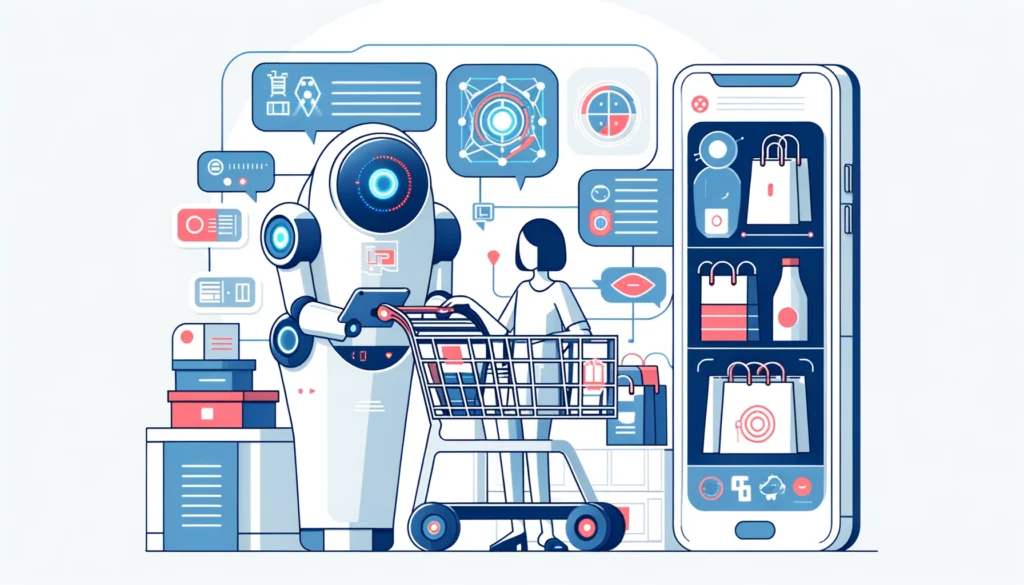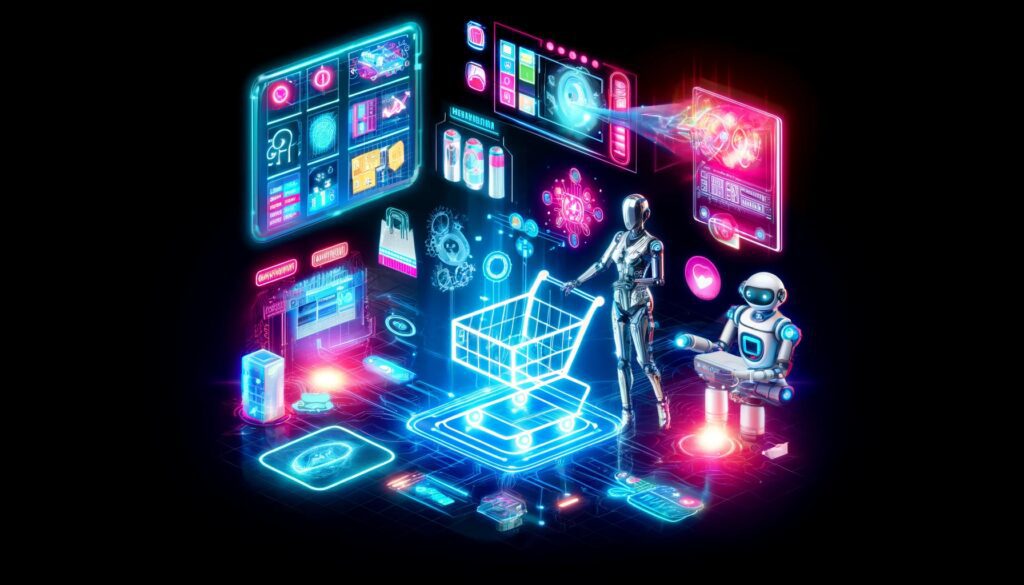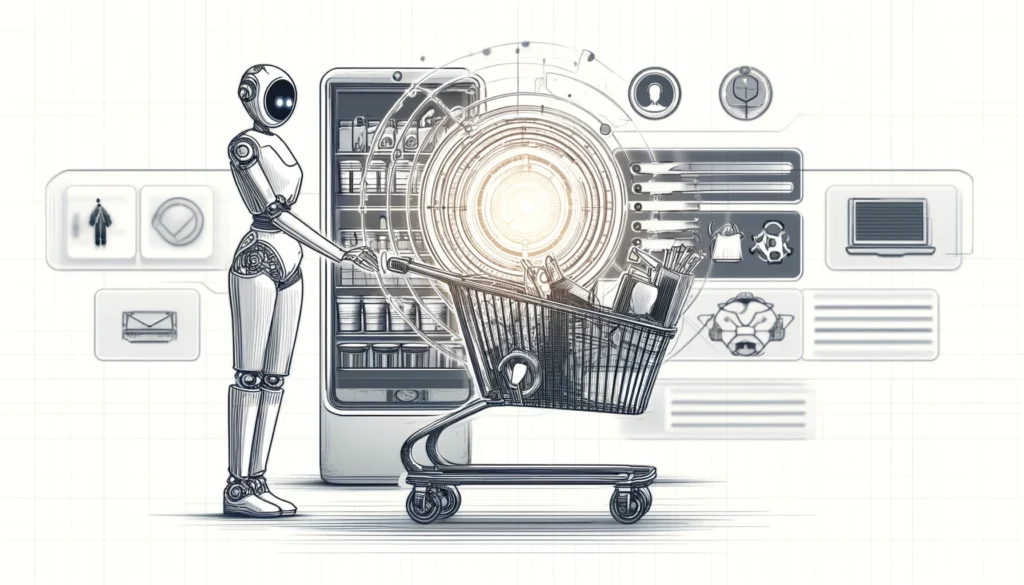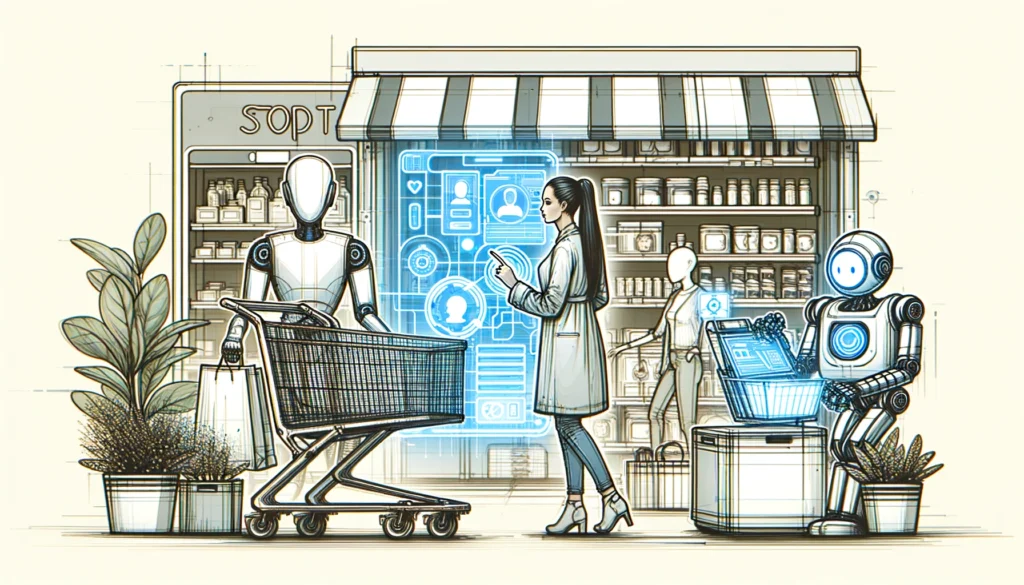
The Future of Shopping: AI Revolutionizes E-commerce in 2024
Introduction
Welcome to the future of shopping, where artificial intelligence (AI) is transforming the e-commerce landscape. In 2024, AI-powered shopping is more personalized, efficient, and intuitive than ever before. This article dives into the key trends and technologies that are revolutionizing how we shop online, offering a glimpse into the dynamic world of AI-driven e-commerce.
AI-Driven Personalization
AI-powered personalization, also known as hyper-personalization, leverages machine learning (ML) and natural language processing (NLP) to analyze customer behavior and preferences in real-time. This technology tailors shopping experiences to individual users, offering personalized recommendations, ads, and dynamic pricing strategies. As AI continues to advance, the capability to deliver a unique shopping journey for each customer becomes increasingly sophisticated and effective.
AI-driven personalization goes beyond traditional methods by utilizing vast amounts of data, including browsing history, purchase patterns, and social media activity. This data is processed to create a comprehensive profile of each shopper, enabling e-commerce platforms to predict their needs and preferences accurately. For instance, if a customer frequently buys athletic wear, AI can recommend related products, seasonal promotions, or new arrivals tailored to their style and preferences.
Enhanced Customer Service with Conversational AI
Conversational AI is revolutionizing customer service in e-commerce. AI chatbots and virtual assistants provide instant, personalized support, enhancing customer satisfaction and engagement. These tools, powered by NLP, can understand and respond to customer queries in a human-like manner, making the shopping experience smoother and more enjoyable. Major retailers like Walmart are at the forefront of adopting these technologies.
Conversational AI can handle various tasks, from answering frequently asked questions to assisting with complex issues like order tracking and returns. These AI systems learn from each interaction, continuously improving their responses and efficiency. By providing 24/7 support, they help reduce wait times and enhance the overall customer experience, leading to higher satisfaction rates and increased loyalty.
Predictive Analytics for Inventory and Demand Forecasting
Predictive analytics, driven by AI, is helping retailers manage inventory more efficiently and forecast demand accurately. By analyzing historical data and current trends, AI can predict which products will be in demand, allowing retailers to optimize stock levels and reduce waste. This foresight is crucial for maintaining a balance between supply and demand.
For example, AI can analyze sales data to identify seasonal trends and predict upcoming demand spikes. Retailers can then adjust their inventory accordingly, ensuring popular items are always in stock while reducing the risk of overstocking less popular products. This approach not only improves operational efficiency but also enhances customer satisfaction by ensuring products are readily available when needed.

AI-Powered Search and Visual Search
AI enhances search capabilities on e-commerce platforms, making it easier for customers to find what they are looking for. Visual search, in particular, allows users to search for products using images instead of keywords, improving the accuracy and relevance of search results. This feature is becoming a game-changer in online shopping.
Visual search uses AI to analyze the content of images and match them with similar products available on the platform. For instance, a customer can upload a photo of a dress they like, and the AI will find similar dresses available for purchase. This technology streamlines the shopping process, making it more intuitive and engaging.
Dynamic Pricing Strategies
AI algorithms enable dynamic pricing strategies that adjust prices in real-time based on market demand, competitor pricing, and customer behavior. This flexibility helps retailers maximize revenue and stay competitive in a fluctuating market. Dynamic pricing powered by AI ensures that customers get the best possible price, enhancing their shopping experience.
Dynamic pricing takes into account various factors, such as the time of day, customer location, and even the weather, to set optimal prices. For example, a retailer might increase prices for umbrellas during a rainy day in a specific region. By leveraging AI, businesses can implement sophisticated pricing strategies that boost sales and profitability.
Personalized Marketing and Advertising
AI is transforming marketing by enabling the creation of highly personalized ads and content. By analyzing user data, AI can determine the most effective messaging and delivery methods for each individual, increasing the effectiveness of marketing campaigns and improving conversion rates. Personalized marketing is becoming a standard practice in the e-commerce industry.
AI-driven marketing platforms can segment audiences based on detailed criteria, such as purchasing behavior, demographics, and interests. This allows marketers to create targeted campaigns that resonate with specific customer segments. For instance, a fitness brand might target health-conscious consumers with personalized workout tips and product recommendations, leading to higher engagement and conversion rates.

Streamlined Logistics and Delivery
AI improves logistics by optimizing delivery routes, predicting delays, and managing warehouse operations more efficiently. Retailers like Walmart are extending AI-driven drone delivery services to enhance the speed and reliability of deliveries. This technology ensures that customers receive their orders faster and more reliably.
AI can analyze traffic patterns, weather conditions, and delivery schedules to optimize routes for delivery vehicles. This reduces delivery times and fuel consumption, leading to cost savings and environmental benefits. Additionally, AI can predict potential disruptions, such as severe weather, allowing retailers to proactively adjust their logistics plans and minimize delays.
AI-Powered Visual Merchandising
AI helps retailers design more effective visual merchandising strategies by analyzing customer interactions with products. This data-driven approach allows for the optimization of product displays and the layout of online stores, enhancing the overall shopping experience. Visual merchandising powered by AI can significantly boost sales and customer engagement.
For example, AI can track how customers navigate an online store, identifying which products attract the most attention and which layouts encourage purchases. Retailers can use this information to create visually appealing and strategically organized product displays that enhance the shopping experience and drive sales.
Enhanced Security and Fraud Prevention
AI enhances security measures by detecting and preventing fraudulent activities. By analyzing transaction patterns and user behavior, AI systems can identify suspicious activities in real-time, protecting both retailers and customers from fraud. Enhanced security measures are critical for maintaining trust in e-commerce platforms.
AI can detect anomalies in transaction data, such as unusual purchase patterns or multiple transactions from different locations within a short time frame. When suspicious activity is detected, the system can automatically flag the transaction for further investigation or block it entirely. This proactive approach helps prevent fraud and enhances the security of online shopping.
AI in Sustainable E-commerce Practices
AI supports sustainable e-commerce practices by optimizing resource use and reducing waste. For example, AI can improve supply chain efficiency, reducing the environmental impact of transportation and production processes. Sustainability is becoming a key focus for many e-commerce businesses.
AI can analyze data from various sources to identify opportunities for reducing energy consumption and waste. For instance, AI can optimize delivery routes to minimize fuel usage or predict demand more accurately to reduce overproduction. These sustainable practices not only benefit the environment but also enhance the brand’s reputation among eco-conscious consumers.
Integration with Wearable Technology
Wearable technology incorporating AI, such as smart glasses and AI pins, is becoming more prevalent. These devices offer innovative ways for consumers to interact with retailers and make purchases, further integrating AI into daily life. The future of wearable technology in e-commerce is bright, with numerous possibilities for enhancing the shopping experience.

Personalized Shopping Assistance
One of the most significant benefits of AI-powered wearable technology is the ability to provide personalized shopping assistance. Smart glasses equipped with AI can analyze a user’s preferences, past purchases, and browsing history to suggest products tailored to their tastes. As a consumer walks through a store or browses online, their wearable can display product recommendations, special offers, and reviews, creating a highly personalized and efficient shopping experience.
Seamless Payment Systems
Wearable technology can also streamline the payment process, making transactions faster and more secure. AI-enabled wearables can support contactless payment methods, allowing consumers to complete purchases with a simple tap or gesture. Additionally, these devices can use biometric authentication, such as facial recognition or fingerprint scanning, to ensure secure transactions without the need for physical cards or cash.
Augmented Reality Shopping
Smart glasses with augmented reality (AR) capabilities can revolutionize the way consumers shop. In physical stores, AR can provide additional information about products, such as nutritional facts for food items or care instructions for clothing, by simply looking at them. Online shoppers can use AR to visualize how products will look in their homes or on themselves, reducing the uncertainty and increasing confidence in their purchases.
Voice-Activated Shopping
AI pins and other wearable devices with voice recognition capabilities can facilitate hands-free shopping. Consumers can use voice commands to search for products, compare prices, and make purchases, making the shopping process more convenient, especially when multitasking or on the go. This integration of voice-activated technology can significantly enhance the user experience by providing a quick and effortless way to interact with e-commerce platforms.
Real-Time Customer Support
Wearable technology can provide real-time customer support through AI-powered virtual assistants. These assistants can answer queries, provide product information, and guide consumers through the purchasing process. In-store, AI-enabled wearables can connect with store staff or virtual helpdesks to resolve issues instantly. This immediate access to support can enhance customer satisfaction and reduce the likelihood of abandoned carts.

Inventory Management and Notifications
For retailers, wearable technology can improve inventory management and provide timely notifications about stock levels. AI-enabled wearables can track inventory in real-time and alert staff when items need to be restocked. For consumers, wearables can notify them when products they are interested in are back in stock or when there are limited-time offers. This level of integration ensures that both retailers and consumers are always informed and can act promptly.
Data-Driven Insights
The integration of AI in wearable technology allows for the collection of vast amounts of data on consumer behavior and preferences. Retailers can analyze this data to gain insights into shopping trends, optimize product offerings, and create targeted marketing campaigns. Consumers benefit from a more personalized shopping experience, as AI algorithms can predict their needs and preferences with greater accuracy.
Enhanced Security and Privacy
AI-powered wearables can also enhance security and privacy in e-commerce. Advanced encryption and biometric authentication methods protect consumer data during transactions. Moreover, AI can detect and prevent fraudulent activities by analyzing patterns and anomalies in purchasing behavior, ensuring a safer shopping environment for users.
Smart Glasses and AI Pins
Smart glasses equipped with AI can provide real-time information about products as customers browse in-store or online. These devices can display product details, reviews, and recommendations, making the shopping experience more interactive and informative. For example, if a shopper is looking at a pair of sneakers, the smart glasses could show the latest reviews, alternative colors, and sizes available, and even suggest matching accessories.
AI pins, wearable devices that clip onto clothing, offer another layer of interaction. These pins can alert users to special promotions, provide navigation assistance within large retail stores, and even facilitate quick, hands-free payments. Imagine walking into a store and receiving instant notifications about sales on your favorite brands or directions to the aisle where your desired product is located.
Health and Fitness Integration
For health and fitness enthusiasts, wearable technology integrated with AI can track physical activity and provide personalized shopping recommendations. For instance, a smartwatch that monitors running habits could suggest the best running shoes based on the wearer’s gait analysis and previous purchase history. This integration not only enhances the shopping experience but also provides value-added services that align with the consumer’s lifestyle.
Convenience and Accessibility
Wearable technology also improves accessibility for consumers with disabilities. AI-driven features in smart glasses can assist visually impaired shoppers by reading product labels or guiding them through store aisles. Similarly, hearing-impaired customers can benefit from real-time transcription services provided through wearable devices, ensuring they receive the same level of information and assistance as other shoppers.
Future Prospects
The integration of AI with wearable technology is set to expand, offering increasingly personalized and immersive shopping experiences that cater to the specific needs and preferences of each consumer. Here’s a closer look at the exciting future prospects:
Advanced Augmented Reality (AR) Experiences
Future smart glasses are expected to incorporate even more advanced AR capabilities. Shoppers could see virtual overlays of products in their environment, try on clothes virtually, or visualize how furniture would look in their homes without needing to leave their current location. This immersive experience bridges the gap between online and physical shopping, providing a richer and more engaging shopping journey .
Seamless Payment Solutions
AI-integrated wearable technology is poised to revolutionize payment systems. Future wearables could facilitate seamless, secure, and instant payments. For example, AI pins might enable users to authorize transactions with a simple voice command or gesture, leveraging biometric data for enhanced security. This innovation simplifies the checkout process, making shopping more convenient and efficient.
Enhanced Health Monitoring and Recommendations
Wearable devices will likely continue to evolve in their health monitoring capabilities. Advanced AI algorithms could offer personalized health and wellness recommendations based on real-time data collected from smartwatches and fitness trackers. These insights could range from dietary suggestions to tailored fitness plans, creating a holistic approach to health and lifestyle that directly influences shopping choices .
Integration with Smart Home Devices
Future wearable technology could integrate seamlessly with smart home devices, allowing users to control their environment through their wearables. This integration brings a new dimension to convenience and interconnectivity in various aspects of daily life, including the shopping experience.
Enhanced Shopping Experience
Imagine a scenario where your smart refrigerator, equipped with advanced sensors and AI, monitors the inventory of your groceries. When it detects that you are running low on essential items like milk, eggs, or vegetables, it sends a notification directly to your smart glasses or smartwatch. You can immediately review the list and, with a simple voice command or gesture, place an order from your preferred grocery store. This streamlined process eliminates the need for manual checks and ensures you never run out of important supplies.
Home Automation and Control
Wearables can also serve as a central hub for controlling various smart home devices. For example, as you walk through your home, your wearable could automatically adjust the lighting and temperature based on your preferences. If you receive a call or a message, your wearable can sync with your smart speaker to pause your music and notify you. Additionally, integration with security systems means you can receive real-time alerts and even view security camera footage directly on your wearable, enhancing your home’s safety.
Health and Wellness
Integration with smart home devices can extend to health and wellness applications as well. For instance, wearables could sync with your smart bed to track your sleep patterns and adjust the mattress firmness or room temperature to optimize your sleep quality. Your wearable could also communicate with kitchen appliances to suggest meals based on your dietary needs and current health metrics, such as blood sugar levels or heart rate, creating a personalized wellness ecosystem.
Energy Efficiency
Smart home integration through wearables can significantly contribute to energy efficiency. Your wearable could sync with smart thermostats and lighting systems to optimize energy usage based on your presence and activity. If you leave a room or the house, your wearable can signal these devices to reduce energy consumption, ensuring that your home is both comfortable and eco-friendly.
Entertainment and Media
Wearables could enhance your entertainment experience by acting as a remote control for your smart TV, sound system, and other media devices. Imagine adjusting the volume or changing the channel with a simple hand gesture or voice command. Moreover, your wearable could suggest content based on your viewing history and preferences, creating a more personalized and immersive entertainment experience.
Personalized Shopping Assistants
AI-powered personal shopping assistants, integrated into wearable devices, will offer a new level of personalization. These assistants could provide real-time advice and suggestions based on the user’s preferences, previous purchases, and current trends. For example, as a user walks through a store, their smart glasses could highlight items on sale that match their style and alert them to loyalty rewards they can redeem, making the shopping experience highly tailored and efficient.
Sustainability and Ethical Shopping
AI and wearable technology can also promote more sustainable and ethical shopping practices. Devices could inform consumers about the environmental impact of their purchases, suggest eco-friendly alternatives, and provide information about the ethical practices of brands. This empowers consumers to make more informed and responsible shopping decisions.
People Also Ask About AI-Powered Shopping
How is AI changing the way we shop online?
AI is making online shopping smarter and more personalized than ever! It analyzes your browsing habits and purchase history to suggest products you might love. Plus, with AI chatbots, you can get instant help with your orders, making the whole experience smoother and more enjoyable.
What is AI-powered personalization in e-commerce?
AI-powered personalization, or hyper-personalization, tailors the shopping experience to your unique preferences by analyzing vast amounts of data. This means you’ll see products and offers that are highly relevant to you, which makes shopping more convenient and engaging.
How do AI chatbots improve customer service in online shopping?
AI chatbots are like your personal shopping assistants that never sleep. They can answer questions, help you find products, and even track your orders 24/7. This instant support helps reduce wait times and makes shopping online a breeze.
What are the benefits of dynamic pricing with AI?
Dynamic pricing with AI means you get the best price based on current market demand, competitor prices, and your own shopping behavior. It helps retailers stay competitive and ensures you’re getting fair and sometimes even lower prices on products.
How does AI help with inventory management for online stores?
AI helps retailers keep the right amount of stock by predicting what products will be in demand. It looks at past sales data and current trends to make sure popular items are always available, which means fewer out-of-stock frustrations for you.
What is visual search and how is AI improving it?
Visual search lets you find products by simply uploading a photo instead of typing in keywords. AI analyzes the image to show you similar items, making it super easy to find exactly what you’re looking for, even if you don’t know what it’s called.
How is wearable technology integrated with AI in shopping?
Wearable tech like smart glasses and AI pins are making shopping more interactive. Imagine walking into a store and your smart glasses showing you product details or sales, or using an AI pin to get instant notifications about discounts. It’s like having a personal shopping assistant right with you!
Why is AI important for personalized marketing in e-commerce?
AI makes marketing more relevant to you by analyzing your interests and shopping habits. This means the ads and offers you see are tailored just for you, making shopping not only more enjoyable but also more effective for retailers.
For more detailed information, visit the following sources:
Conclusion
AI-powered shopping is set to revolutionize the e-commerce industry in 2024, offering unprecedented levels of personalization, efficiency, and convenience. The integration of AI with wearable technology is particularly promising, providing immersive and personalized experiences that cater to the specific needs of each consumer. As AI technology continues to advance, retailers and consumers alike can look forward to a more intuitive and satisfying shopping experience.





